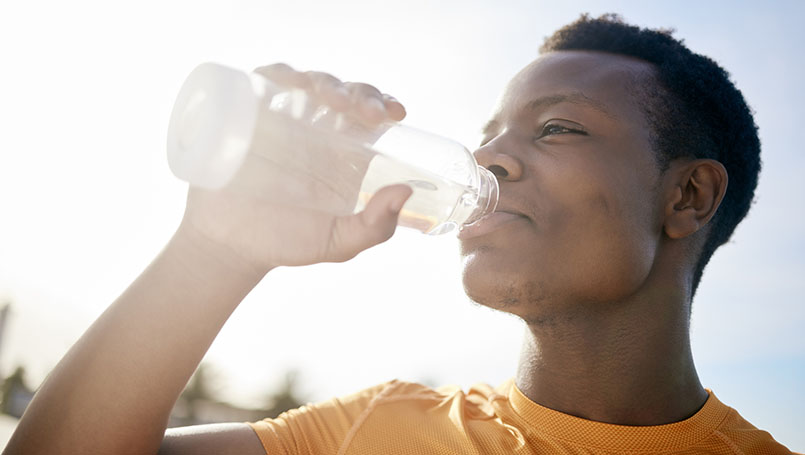Tuesday, July 18, 2023

As the mercury rises throughout the summer, heat illness is a concern, particularly among the young, elderly and those who exert themselves on the athletic field or elsewhere.
So if you’re getting out and about this summer, whether it’s working in your backyard garden, running along the beach, or playing sports at the park, make sure you know the signs of the different types of heat-related illness and what to do about them.
5 main types of heat-related illness
Heat cramps
What it is: This is cramping you may feel in your muscles due to dehydration, electrolyte imbalances, muscle fatigue, or any combination of these factors.
Symptoms may include heavy sweating, thirst, fatigue, and pains in the arms, abdomen or legs. That Charley horse is more than pain, it’s a sign that something’s off in your body. Pay attention.
What to do: Drink plenty of cool water and sports drinks with electrolytes. Rest in a cool location out of the sun.
Heat syncope
What it is: Heat syncope often occurs in people who have not acclimatized to the heat, someone who has been sitting or standing for a long time, immediately after stopping activity, or after getting up quickly from resting or being seated.
Symptoms include fainting for a short period of time, dizziness and feeling light-headed. It is attributed to rapidly opening blood vessels in the extremities, pooling of blood, poor return of blood to the heart, dehydration, reduced heart output, and blood flow changes in the brain.
What to do: Sit or lie down in a cool place and slowly drink water, sports drinks or clear juices.
Exercise or heat exhaustion
What it is: Exhaustion occurs most frequently in hot and humid temperatures, and is often hard to distinguish from a heat stroke when it is in its worst stages.
Symptoms include heavy sweating, the inability to continue exercise due to energy depletion, cold and clammy skin, a rapid pulse, headache, dizziness, nausea, diarrhea, decreased urine output, weakness, pallor (the person may look pale), persistent muscle cramps across the entire body, fainting, hyperventilation, and body temperatures that range from 97-103 degrees. This is the stage of heat illness right before heat stroke.
What to do: Heat exhaustion must be recognized and treated quickly. Offer first aid and medical care. Any excess clothing (including shoes or hats) as well as water- or sweat-soaked clothing should be removed. If the person is alert and not vomiting, have them drink cold sports drinks or cold water if sports drinks (with sodium) are not available. Move the person to a cooler location, place ice packs on the body, especially targeting the armpit, groin and neck. Use cold towels on the hands, feet and head. Blow cool air on the person. Consider immersion in cold water. If the person’s temperature rises past 102 degrees, or dizziness persists after lying the person down with their legs elevated, seek emergency medical attention.
Heat Stroke
What it is: Heat stroke is life threatening. It occurs when the body’s temperature regulatory system is overwhelmed. This generally occurs from extreme outdoor conditions that do not allow the body to cool itself.
Symptoms include dry and hot skin, nausea, irrational behavior, rapid and shallow breathing, rapid and weak pulse, disorientation, drowsiness and a temperature above 104 degrees.
What to do: Call 911 or seek emergency medical care. In the meantime, move the person to a cool location, remove excess clothing including shoes and hats, place ice packs on the body, especially targeting the armpit, groin and neck. Immerse the individual in cold water if possible. Use cold towels on the hands, feet and head. Blow cool air on the person. Health care workers often use intravenous (IV) fluids to rapidly hydrate the person suffering from heat stroke. Blood tests and urinalysis will often be performed to make sure that the body is returning to normal. After a heat stroke it is possible to see complications with internal body temperature regulation. Sometimes recovery after a heat stroke may take up to one year before the central nervous system, liver and kidney functions are considered normal.
Exertional hyponatremia
What it is: Exercise-associated hyponatremia is a rarely occurring condition that occurs when a person ingests too much water or low sodium beverages relative to the amount of sweat that is released from the body. This creates a low-sodium level in the body. The result can cause possible fatal neurological and physiologic dysfunctions.
Symptoms include disorientation, altered mental status, headache, vomiting, lethargy, swelling of hands and feet, pulmonary edema, cerebral edema and seizures.
What to do: Call 911 or seek emergency medical care. This condition may be treated through fluid reduction in the body and beverages that contain sufficient sodium.
